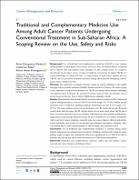| dc.contributor.author | Mwaka, Amos Deogratius | |
| dc.contributor.author | Abbo, Catherine | |
| dc.contributor.author | Kinengyere, Annet Alison | |
| dc.date.accessioned | 2021-04-29T08:25:11Z | |
| dc.date.available | 2021-04-29T08:25:11Z | |
| dc.date.issued | 2020-05-20 | |
| dc.identifier.citation | Mwaka, A.D., Abbo, C. and Kinengyere, A.A., 2020. Traditional and Complementary Medicine Use Among Adult Cancer Patients Undergoing Conventional Treatment in Sub-Saharan Africa: A Scoping Review on the Use, Safety and Risks. Cancer management and research, 12, p.3699. | en_US |
| dc.identifier.issn | 1179-1322 | |
| dc.identifier.uri | http://hdl.handle.net/20.500.12280/2787 | |
| dc.description.abstract | Background: Use of traditional and complementary medicine (T&CM) is very common among patients in sub-Saharan Africa (SSA). However, there are limited data on concurrent use of T&CM with conventional cancer therapies. In this scoping review, we sought to describe the (i) prevalence of use, (ii) types of medicine, (iii) reasons for taking T&CM, (iv) current knowledge on safety and risks, (v) characteristics of adult cancer patients who use T&CM, and (vi) perceived treatment outcomes among cancer patients undergoing conven tional cancer treatment in SSA.
Methods: We conducted a systematic literature search for articles published in the English language in three scientific databases (PubMed, Embase and Web of Science). We used a scoping review approach to map relevant literature on T&CM use among cancer patients undergoing conventional cancer treatments. We assessed 96 articles based on titles and abstracts, and 23
articles based on full text. Twelve articles fulfilled preset eligibility criteria.
Results: More than half of the included articles were from only two countries in SSA: Nigeria and Uganda. Median prevalence of use of T&CM was 60.0% (range: 14.1–79.0%). Median percent disclosure of use of T&CM to attending healthcare professionals was low at 32% (range: 15.3– 85.7%). The most common reasons for non-disclosure were: the doctor did not ask, the doctor
would rebuke them for using T&CM, and the doctors do not know much about T&CM and so there is no need to share the issue of use with them. T&CM used by cancer patients included herbs, healing prayers and massage. Reported reasons for use of T&CM in 8 of 12 articles included the wish to get rid of cancer symptoms, especially pain, cure cancer, improve physical and psychological well-being, treat toxicity of conventional cancer therapies and improve immunity. There were limited data on safety and risk profiles of T&CM among cancer patients in SSA.
Conclusion: Use of traditional and complementary medicines is common among cancer patients undergoing conventional cancer treatments. Healthcare professionals caring for cancer patients ought to inquire and communicate effectively regarding the use of T&CM in order to minimize the risks of side effects from concurrent use of T&CM and biomedicines. | en_US |
| dc.language.iso | en | en_US |
| dc.publisher | Dove press Ltd | en_US |
| dc.relation.ispartofseries | Cancer management and research;12 | |
| dc.subject | Traditional and complementary medicine | en_US |
| dc.subject | Safety and risk profiles | en_US |
| dc.subject | Cancer | en_US |
| dc.subject | Conventional cancer therapy | en_US |
| dc.subject | Sub-Saharan Africa | en_US |
| dc.title | Traditional and Complementary Medicine Use Among Adult Cancer Patients Undergoing Conventional Treatment in Sub-Saharan Africa: A Scoping Review on the Use, Safety and Risks | en_US |
| dc.type | Article | en_US |


